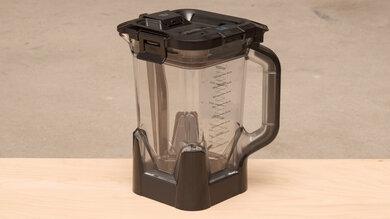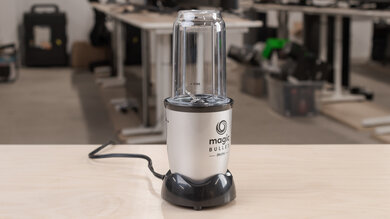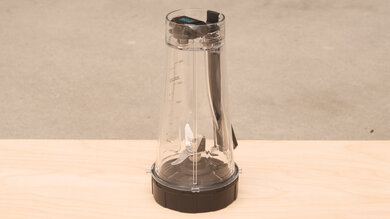- Table of Contents
- Intro
- When It Matters
- Our Tests
- What's Not Included
- Conclusion
- Comments
A blender that can whip up drinks and snacks at the push of a button can save you a lot of time in the kitchen, but if it's tedious to clean, your first time making creamy homemade almond butter could also be your last. No one likes to spend time cleaning another appliance, but there isn't any particular design or characteristic that tells you a blender is easy to clean. To give you an idea of what it's like to clean a specific model, we wash each blender after our tests for smoothies and then again after making almond butter. We describe our experience and assign a subjective score that describes how easy or difficult the overall process is.
Test results
When It Matters
You may be looking for a blender that's easy to clean if you're planning to use your machine several times a day. You may have had a blender that was difficult to clean and want to avoid the same issue. It's good to know how easy a blender is to clean if you're planning to make almond butter or other recipes with a similarly sticky or dry consistency since this type of food can be very complicated to clean out of some blenders. Also, since the cleaning tests relate to our experience of washing the blender without a dishwasher, the results are particularly relevant if you don't have a dishwasher or are considering a blender that isn't dishwasher-safe.
Our Tests
We evaluate how easy it is to clean the blender after making a smoothie and after making almond butter. We do it in two parts: after the smoothie test and after the almond butter test.
We clean the jar, lid, and blade assembly used for the previous smoothie or almond butter test. If it's an immersion blender, we use the included beaker or our own 32oz OXO beaker, depending on which we used for the previous test. To clean the blender, we initially fill the jar halfway with warm water and add a few drops of dish soap. Then we run it at top speed for one minute or use the cleaning preset if there is one. Afterward, we check the blades for food residue and use a spatula to clean them if needed. We then use a sponge to wipe down any part of the blender that isn't already clean.
We evaluate the ease of cleaning based on how much food was cleaned away by the one-minute rinse or cleaning cycle. If the blender isn't completely clean, we consider if there's any nut butter left under the blades, how difficult it is to reach, and whether there are any other hard-to-reach spots to clean.
We describe the experience of cleaning the blender after making a smoothie and almond butter separately, using one of these descriptors for each test: 'Simple', 'Ok', 'Difficult', or 'Nightmarish'. The score is then subjectively assigned based on how easy the blender is to clean overall and compared to other products to ensure consistency in our scoring. For a perfect score of 10, the blender has to ideally be completely clean after the one-minute blend with soap and water.
Smoothie Cleaning
Most blenders that we've tested are easy to clean after making our kale, orange juice, and frozen banana smoothie. Since the ingredients are liquidy, the one-minute blend with soap and water usually takes care of most, if not all, of the mess, so you don't need to worry about sticking your hand in the jar to clean the sides or reaching under the blades.
Some blenders require more work than most to clean up after smoothie-making because of their particular design. The NutriBullet Blender Combo traps bits of kale under its blades, and the Ninja DUO comes with an additional jar with a vacuum tube inside that can trap food between the jar's walls, requiring you to take it apart with a screwdriver to get at food debris. However, the process isn't too difficult overall, and both of these blenders have a 'simple' result for the smoothie cleaning test.
 The Ninja DUO is a full-size blender and has one of the lowest scores for overall cleaning at 6.0.
The Ninja DUO is a full-size blender and has one of the lowest scores for overall cleaning at 6.0. The blenders that score the best on the cleaning test are full-size models like the Blendtec Classic 575. However, if you mainly use your blender to make smoothies and want something easy to clean, you may prefer a personal blender with a somewhat lower score, like the Ninja Nutri Ninja Pro. They may be harder to clean overall than the top-scoring models, but you can often drink out of the blending jar, and they don't usually come with a tamper or separate lid for the container, which can save you a few dishes. Similarly, if you mostly make soups or other hot foods, cleaning liquidy ingredients from an immersion blender can be as simple as rinsing the blending shaft.
 Many personal blenders like the Magic Bullet Mini are simple to clean after making a smoothie. It's difficult to clean almond butter out of the jar, though.
Many personal blenders like the Magic Bullet Mini are simple to clean after making a smoothie. It's difficult to clean almond butter out of the jar, though. Most immersion blenders are very easy to rinse clean after making a smoothie, including ones that have average cleaning scores, like the KitchenAid KHBBV53, which is more difficult to clean after making almond butter.
Most immersion blenders are very easy to rinse clean after making a smoothie, including ones that have average cleaning scores, like the KitchenAid KHBBV53, which is more difficult to clean after making almond butter.
Almond Butter Cleaning
It's usually harder to clean almond butter from a blender than a smoothie. This sticky ingredient can get stuck under the blades or in ridges in the jar, requiring you to spend time scrubbing with a sponge, which can pose a risk of cutting yourself in the process. While it's not uncommon for a blender to rinse clean after being used for a smoothie, it's rarer to completely clean almond butter out of a blender just by running it with soap and water. So, the difference between the top and lowest scoring blenders most often has to do with how easy or difficult it is to clean out after making almond butter.
The blenders that score the highest on the cleaning test are the Breville The Q and the Blendtec Classic 575. They each score a 9.5, meaning there's hardly any residue left after the rinse with soap and water. With the Blendtec, there's a 'spoonula' tool that helps to scoop the almond butter out of the jar more efficiently before cleaning it, while the Breville's seems to have a non-stick property that makes it easy to rinse clean.
 It's exceptionally easy to clean the Blendtec 575. After you scoop out the almond butter with the included 'spoonula', running the blender with soap and water takes care of the rest.
It's exceptionally easy to clean the Blendtec 575. After you scoop out the almond butter with the included 'spoonula', running the blender with soap and water takes care of the rest. The Bella Rocket Blender's small, narrow jar makes it difficult to clean after making almond butter.
The Bella Rocket Blender's small, narrow jar makes it difficult to clean after making almond butter.More often, you have to wipe the blender with a sponge after rinsing it. Blenders like the Ninja Foodi Power Pitcher System and the Vitamix Explorian E310 are still 'simple' to clean after making almond butter and score very well on the cleaning test even though the one-minute rinse isn't quite enough to get them clean. While full-size models generally perform the best when making almond butter, other blenders can also be simple to clean after using them for this purpose. Some immersion blenders like the All-Clad KZ750DGT and personal blenders like the Ninja Foodi Power Nutri DUO only need a quick wipe with a sponge after running them with soap and water.
Blenders receive lower scores and a 'Difficult' result on the almond butter cleaning test when the clean-up process is more complicated. The Breville Boss To Go Sport is hard to clean after making almond butter unless you soak it first, and the KitchenAid K150 Blender's fixed blades make it a bit difficult to clean the jar with a sponge. Both models are 'difficult' to clean after making almond butter and have a total cleaning score of 7.5.
A score lower than 7.5 means the blender is at least a little tedious to clean. This can be because of the shape of the jar, like the BELLA Rocket Blender or the KitchenAid Diamond, which have narrow jars that are awkward to reach. Also, sometimes there are ridges on the lid or jar that are difficult to properly clean, which is the case for the NutriBullet Smart Touch Blender Combo. A score of less than 5.5 means the process is so tedious that cleaning the blender doesn't feel worth the effort, but none of the blenders we've tested so far have scored that poorly.
What's Not Included
We don't wash any part of the blender in a dishwasher, so whether a blender is dishwasher-safe or not isn't included in the cleaning score. If you want a blender that you can put in your dishwasher, you can find out if different parts of a model are advertised to be dishwasher-safe in the 'Main Jar/Beaker', 'Additional Jar', and 'Blades' sections of each review. Sometimes only certain parts are dishwasher-safe, and sometimes they can only be placed on the top rack, so it's good to look for this information if a dishwasher-safe blender is a priority for you.
Similarly, it won't necessarily hurt the score if a blender has non-removable blades or if they're sharp versus dull, but you may have a preference one way or another when it comes to cleaning your blender. While this test considers all the jars we used for the smoothie test, which is often at least two, we don't test any extra accessories like food processor attachments, and they aren't part of the cleaning test.
Conclusion
A blender that's easy to clean can save you time and frustration, especially if you use it often. Many different factors can affect how easy it is to clean a particular model, from the shape of the jar to the angle of the blades. You can take a look at the results of this test to make sure the personal blender you're considering is easy to rinse clean, or if you want a blender that you can use to make almond butter without having to spend time scrubbing after.
